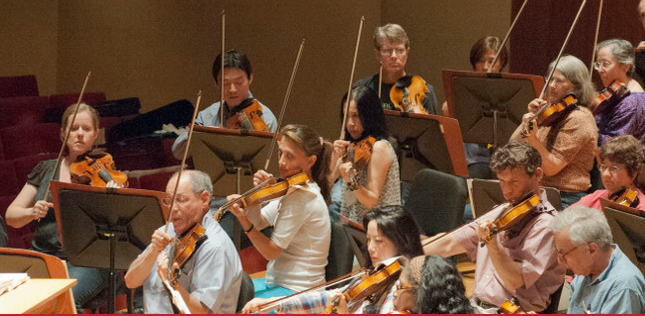Pro-Am Orchestra Events: Trending Across the Country
Michael Stugrin, writing in the spring 2015 issue of Symphony magazine (page 42), presents an interesting overview of a new trend among orchestras − performing with amateurs. Most orchestras have been doing “side by side” performances with their local youth orchestra for decades (I played such a concert with the Boston Symphony at Symphony Hall way back in the 60s). The new trend is to perform with adult amateurs.
“Orchestras and conservatories … are recognizing that music is often a deep and unbreakable tie between youth and adulthood, and between passionate former musicians and orchestras that need their support. At a deep social level, music making is a communal and community-building activity.”
Mr. Stugrin presents a tour of orchestras, large and small, across the country who are offering such opportunities to talented amateurs. A brief summary:
- The Eugene (Oregon) Symphony has developed Play It Again! Adult Chamber Ensembles, which creates “a lifelong framework for continuing music education,” according to Executive Director Scott Freck. More than 60 people participated in their first year, four years ago. Play It Again! sessions are offered twice a year for a $65 fee. Participants are grouped into chamber ensembles coached by an ESO musician. Last spring the program had 16 ensembles, with participants ranging from 18 to 80; each ensemble met six times, culminating in a prucli concert. Some ensembles keep playing on their own, and many participants have become symphony subscribers.
- The San Francisco Symphony created the Community of Music Makers, inspired by research that showed that 76% of their audience played an instrument or sang in a chorus earlier in life. The program supports the many existing amateuer groups in the Bay area, and offers workshops and performance opportunities to adult musicians, both players and singers. Last spring’s choral event attracted 400 participants and enabled the amateur choristers to work with the San Francisco Chorus and perform with the SF symphony. The instrumental program provides SF Symphony musician mentors to participants, on a one-on-one basis, which has created a new perspective towards the symphony and its musicians.
- The Baltimore Symphony perhaps started this trend with its “Rusty Musicians with the BSO” intiative. They have expanded and now offer the BSO Academy. The original program was an immediate success, with 400 “rusty” musicians participating over two days. Four years later, the BSO Academy has four tracks: orchestral, chamber orchestra, arts administrator, and the Music Education Academy in collaboration with the University of Maryland.
- The Buffalo Philharmonic Orchestra has an annual Fantasy Camp, modeled after the Minnesota Orchestra’s Fantasy Camp. This year, the Buffalo Philharmonic collaborated with the World Doctors Orchestra, and orchestra of practicing or retired physicians and medical academics. Spearheaded by Fred Albrecht, a Buffalo carilogist and bassoonist, 40 doctors came to Buffalo for five intensive days and a final concert, which raised $15,000 for the new John R. Oishei Children’s Hospital in Buffalo.
- The Longy School of Music in Cambridge, Massachusetts, has developed a Sistema Side by Side Orchestra, where conservatory students mentor young children who participate in El Sistema programs across the state.
Other orchestras with pro-am programs include the Boston Symphony’s “Onstage at Symphony,” the Black Pearl Chamber Orchestra’s “Citywide Side by Side,” the Oklahoma City Philharmonic’s “Be the Orchestra,” the New Jersey Symphony’s “#OrchestraYou,” the Philadelphia Orchestra’s “PlayINs,” the Richmond Symphony’s “Come & Play,” and the Utah Symphony’s “Pro-Am” program.
To sum up, Mr. Stugrin states, “Avocational musicians are reconnecting with music and orchestras in side-by-side performances, intensive training, and ‘pro-am’ events. For these musicians, it’s a dream come true. For orchestras, it’s a vibrant link to their communities.”


This sounds like exactly the sort of thing orchestras of all levels should be doing to deepen the connection between the audience and us. I’d love to get involved with something like this, but the orchestras in which I play are all regional per-service orchestras without service guarantees, and I imagine the bottom line looks a lot better from the management perspective when the players are full-time and salaried, or at least where the CBA has service guarantees, so that there are musician services that are going to be paid for anyway, whether these projects happen or not. Do you know of any per-service orchestras that are making a go of something like this?